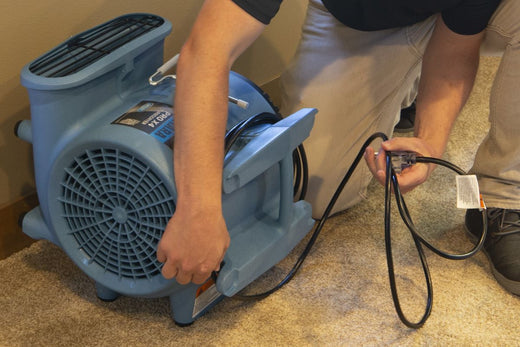By Pat Muller, Ready 2 Respond Trainer
While having the right equipment to handle water damage emergencies is crucial, using it safely is just as important. Without proper safety measures, equipment used during the drying process can pose hazards – from electrical risks to physical injuries. Ensuring facilities team members are well-trained and aware of these risks helps prevent accidents and mitigate potential liability issues.
Here's a checklist of equipment safety best practices to guide teams during remediation work:
Electrical hazards
- Keep electrical cords and equipment away from standing water to minimize shock risk.
- Check power cords to ensure they have a grounded electrical plug and are free of cuts and frays.
- Always plug equipment into Ground Fault Circuit Interrupters (GFCI) or a residual current device (RCD).
- Do not overload circuits or extension cords, as this can create a fire or shock hazard. The National Electric Code (NEC) recommends using no more than 80% of a circuit's capacity – 12 amps on a 15-amp circuit or 16 on a 20-amp circuit.
- Power down equipment fully and properly when it is not in use or during maintenance.
Equipment placement
- Position equipment and cords carefully to avoid creating a trip hazard in walkways and thresholds. Use tape or cord covers to minimize accidents.
- Make sure to check amp limits of units when plugging using on-board GFCI outlets to connect or daisy-chain units in an effort to limit cords crossing high-traffic areas.
- Direct outlets on dehumidifiers away from furnishings so that over-drying does not occur.
- Add ventilation to the work area to prevent overheating of equipment.
- Train staff on proper lifting techniques and protocols for moving heavy equipment from one location to another (using dollies, lifting straps, etc.)
Maintenance protocols
- Review equipment owners’ manuals and follow all indicated safety guidelines and warnings.
- Keep equipment well-maintained, clean, and organized in a designated area.
- Follow a proactive, preventative maintenance schedule that includes filter changes, test runs, inspections, and usage tracking.
- When changing filters used in dehumidifiers or air scrubbers in areas with mold or other contaminants, wear a respirator and bag filters before carrying them through adjacent “clean” areas.
- Replace damaged cords, worn hoses, and inlet and outlet screens as needed.
- Remove equipment from service while repairs are being made and tag appropriately to prevent usage while in maintenance.
In addition to these standard practices, always ensure that equipment procured is safety certified – such as UL, ETL, CE, CSA, or C-UL Listed – to further guarantee its reliability and adherence to safety regulations.
Finally, after setting up equipment at the job site, always look over the area critically: Is there anything that seems unsafe or violates your organization’s safety standards?
If you need help with incorporating equipment safety SOPs into your emergency response planning, contact the Ready 2 Respond team. We’re here to help you. For more Facility Tips and Insights follow us on LinkedIn or subscribe to our Facility Insights newsletter.


Unlocking the Power of Humidity, Airflow, and Temperature
How Dehumidifiers and Airmovers Team Up for Effective Drying